Figures & data
Figure 1. The mTOR pathway is involved in both cancer and senescence. Growth factors, cytokines, insulin, nutrients, and oncoproteins activate the phosphoinositide-3-kinase/mammalian target of rapamycin (PI3K/mTOR) signaling pathway, which promotes cellular growth and cell cycle progression. Mutations that results in constitutive activation of the mTOR pathway are involved in oncogenic transformation when intrinsic controls on cell cycle progression are disabled. Conversely, when mTOR is activated and the cell cycle is arrested, cells enter a senescent state. Rapamycin and other rapalogs (e.g., everolimus) inhibit the mTOR complex 1 (mTORC1) and suppress such a geroconversion.
